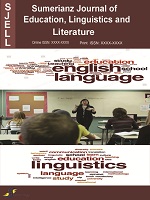Sumerianz Journal of Education, Linguistics and Literature

Online ISSN: 2617-1201
Print ISSN: 2617-1732
Quarterly Published (4 Issues Per Year)
Journal Website: https://www.sumerianz.com/?ic=journal-home&journal=33Archive
Volume 6 Issue 1 (2023)
The ‘Red Colour’ that Cracks Children’s Souls: A Glimpse of Life in the ‘Otef Gaza’ in Israeli Children’s Books
Authors : Lea Baratz
DOI : doi.org/10.47752/sjell.61.20.29
Abstract:This article aims to show children’s books written about children who is living in the Israeli Gaza envelop Since 2001, the residents of the Otef Gaza have lived under the shadow of a continuous security threat, during which five rounds of fighting took place. ‘Red Colour’ is a code name for an alarm that signals people to enter a protected space (shelter). About 20 children’s books have been written on this subject, which allows young readers to examine complex realities through the experiences of literary characters and to engage in cognitive and emotional processing without being directly exposed to the experiences. The research methodology is based on a hermeneutic analysis, which examines the social and cultural processes. Three themes emerge which emphasize the poetic dimension of the use of the concept of the color ‘red’: (1) the symbolic dimension of the concept of “red colour” and (2) the transition from a state of routine to a state of emergency.
The Effect of Mobile-Assisted Language Learning Using Tiny Cards App on Iranian Intermediate EFL Learners’ Vocabulary Learning and Retention
Authors : Zahra Anvarpour Dero ; Majid Pourmohammadi
DOI : doi.org/10.47752/sjell.61.12.19
Abstract:Emerging technologies have brought about major changes in the teaching and learning processes, and there is no doubt that the rapid growth of technology has significantly changed the way English teachers transfer knowledge to their students. Accordingly, this study investigated the effect of MALL using Tiny Cards app on Iranian intermediate EFL learners’ vocabulary learning and retention. It was a quantitative research employing a quasi-experimental design. Forty intermediate EFL learners, taking English course at Farzan English Language Institute, Rasht, Iran, were selected as homogeneous participants based on Quick Placement Test. Next, they were non-randomly divided into one experimental group (N = 20) and one control group (N = 20). Before the onset of treatment, a pretest of vocabulary was administered to certify the learners’ initial knowledge of vocabulary items. The groups then received the treatment on their vocabulary for eight sessions. The experimental group received instruction of vocabulary through Tiny Cards app. The control group, however, received the same items but approached them through traditional method of instruction without MALL. Overall, the results of independent-samples t-tests for the posttest and delayed posttest of vocabulary revealed that there was a statistically significant difference between the two groups in their performance on the posttest and delayed posttest of vocabulary learning and retention. Finally, it was concluded that the findings can be utilized by the teachers, materials developers, and education authorities to provide Iranian EFL learners with MALL vocabulary instruction.
Stakeholders` Perceptions of the Factors Affecting the Teaching and Learning of Early Childhood Development Learners in Marondera Urban
Authors : Beatrice Tayengwa ; Richard Bukaliya
DOI : doi.org/10.47752/sjell.61.1.11
Abstract:This study aimed at establishing stakeholders’ perceptions of factors affecting the teaching and learning of Early Childhood Development (ECD) children in Marondera Urban, Zimbabwe. The study adopted the case study design to provide a detailed understanding of the views voiced by respondents, who included school heads, ECD teachers, and SDC members who represented the community. Questionnaires were administered on ECD teachers while school heads and SDC members were interviewed. Documents on staffing and enrolment were accessed to substantiate claims made by respondents in questionnaires and interviews. A total population of 156 respondents was of interest to this study. The researchers selected 8 primary school heads, 56 ECD teachers and 10 School Development Committee (SDC) members adding up to 74 sampled respondents selected through random sampling. Some of the major findings were that in some instances, unqualified ECD teachers were being recruited as highlighted by most respondents. Most of school heads provided appropriate supervision and guidance to ECD teachers and this positively affected the teaching and learning. Poor remuneration for ECD teachers was negatively affecting the teaching and learning of ECD learners although in some instances NGOs chipped in with some incentives to motivate the ECD teachers. Since the teacher-pupil ratio was higher than what was expected, coupled with the shortage or resources such as furniture, textbooks, workbooks, and other teaching and learning materials at school, this hindered effective teaching and learning of ECD children. The study recommended that there should be more training to ECD teachers so that they become professional personal in the teaching and learning of ECD children to avoid developmental delays. There should be workshops that have to be held at ECD centres especially on the development of ECD children mostly to the para-professional to gain experience. School heads should continue assessing, monitoring, and supervising their ECD teachers to maintain guidance and for the better development of ECD children.



